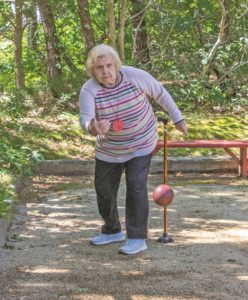TRURO — If there’s a red flag with a “B” waving in front of Maria Redo’s house off Old County Road on Sunday, it means there will be a bocce game that day.
For 31 years, the Redos have been hosting bocce at their summer home here for family, friends, and neighbors. At first, the games were on Wednesdays and Sundays, but as the years went on and life got in the way, bocce became a strictly Sunday tradition.
Maria, who is of Italian descent, is 96 now. She has been playing the game ever since she was a child on Manhattan’s East Side.

“I grew up with a bocce ball court at my parents’ house,” she says. “I knew bocce.” Her father built a summer house in Westchester County in 1930. It had a bocce court.
“All the men played seriously,” Redo says. “After that, the kids and wives would play.”
Bocce is at least 7,000 years old. The earliest evidence of the game is a 5200 B.C. painting of two boys playing, discovered by Englishman Sir Francis Petrial, in an Egyptian tomb, according to worldbocce.org.
Giuseppi Garibaldi, who helped unify Italy in the 1800s, is credited with popularizing the sport as it is known today. The first Bocce Olympiad was held in Athens in 1896, and bocce has been a part of international sports ever since.
The game is played with eight large balls that can be made of wood or plastic, but balls of solid resin or stainless steel are favored by serious players. There is also a small white ball called the pallino.
Two teams of two players each compete on sand or grass. The dimensions of the court don’t really matter for casual games, but an official bocce ball court measures 76 feet long and 12 feet wide.
The game begins with one player tossing the pallino from one end of the court to the other. Players then take turns tossing their large balls (four balls per team) to get as close to the pallino as possible. That determines the score. When all eight balls have been tossed, the players tally up the points and repeat the process going the other way. Games are played to 12, 15, or 21.
Redo and her husband, Frank, a renowned pediatric surgeon at New York Hospital, first visited the Cape in the 1950s and built their Truro house in 1968. During that time, Maria says, bocce was unknown here.
“No one at that time understood the game, but I assured them it was fun,” she says.
Frank built a regulation bocce court in their back yard. In 1990, they started hosting happy hour with bocce, and it became a tradition.
Teams form at the beginning of the summer, and the Redos keep the scoreboard. There’s also a scoreboard to keep track of the games throughout the summer. Team members are assigned a little paper necklace with a number and color so there’s no confusion.
The games started with 8 or 10 couples participating. Thirty-one years is a long time, though. Most of the original players have passed on.
Frank died in 2006. But Maria, their daughter Martha Redo, and niece Mary Cregan have kept the Sunday games going strong.
“You never know who’s gonna be here,” Mary says.
New neighbors and friends have helped make that happen. The family says this summer was one of the biggest groups they’ve ever had. They held a “bocce banquet” on Sept. 5 to celebrate the end of the season.
After a lifetime of tossing, Maria can still play — and her accuracy is spot on.
To determine the score when two balls are very close to each other, a measurement is sometimes needed. The Redo family’s official measuring tool is an old empty tomato sauce can with a string attached to it. The can, the necklaces, the scoreboard, and flag have become Redo family relics because they haven’t been replaced in 31 years.
The games are mostly for fun at the Redo house, but arguments sometimes break out. “Italians take bocce very seriously,” says Maria.



